The SSD Relapse: Understanding and Choosing the Best SSD
by Anand Lal Shimpi on August 30, 2009 12:00 AM EST- Posted in
- Storage
PCMark Vantage: Used Drive Performance
Immediately after finishing my PCMark Vantage runs on the previous page, I wrote one large file sequentially to the rest of the drive. I then deleted the file, rebooted and re-ran PCMark Vantage. This gives us an idea of the worst case desktop performance of these drives as you create, delete and generally just use these drives.
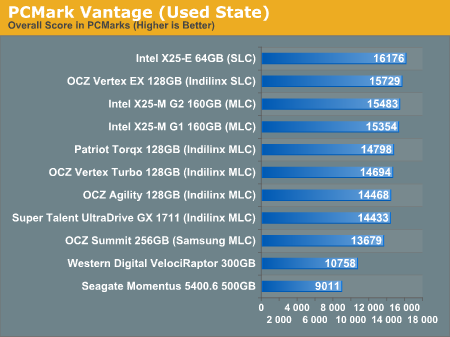
The biggest difference here is that the Samsung based OCZ Summit drops from 5th to 9th place. All of the drives get slower but the Indilinx drives hardly show it. When it comes to dealing with write speed, SLC flash does have the advantage and we see the X25-E and Vertex EX rise to the top of the pack. The G2 is slightly faster than the G1 and the Indilinx drives follow in close pursuit.
The mechanical drives don't change in performance since they don't get slower with use, only as they get more full.
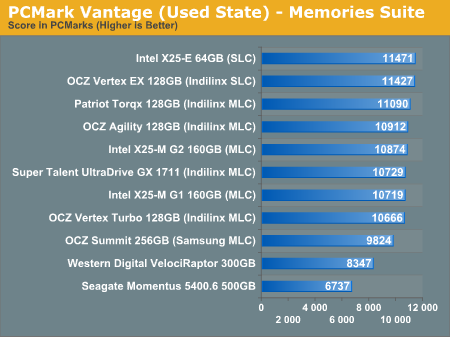
Again we see the two SLC drives at the top, this time followed by a mixture of Indilinx/Intel drives, and the Samsung based Summit is at the bottom of the pack before we get to the HDDs.
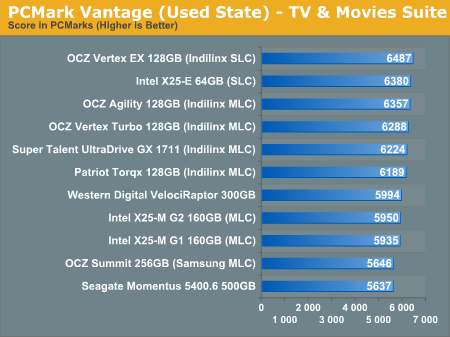
The spread in SSD performance here is only 10% between the slowest non-Samsung drive and the fastest. That tells me that we're mostly CPU bound, but the worst performers other than the Samsung drive are the two Intel X25-Ms. That part tells me that we're at least somewhat bound by sequential write speeds. Either way, the Indilinx drives have a good showing here.
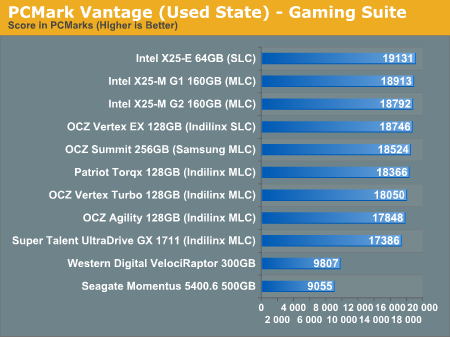
Intel followed by Indilinx SLC with Samsung in league with the MLC Indilinx drives. This is an SSD's dream.

Despite the improvements, the G2 can't touch the much lower write latency of SLC flash here. The Indilinx and Intel G1 drives intermingle while the Samsung drive pulls up the rear. All are faster than a regular hard drive of course.
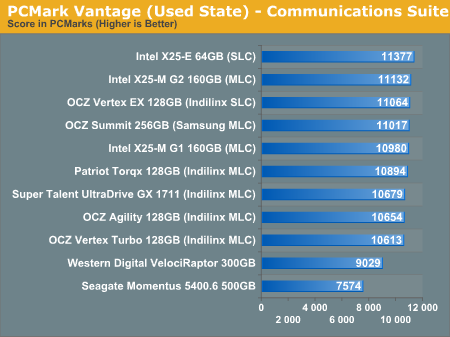

In the multitasking test we once again see Intel rise to the top. The Samsung drive does surprisingly well and the Indilinx drives continue to perform admirably.
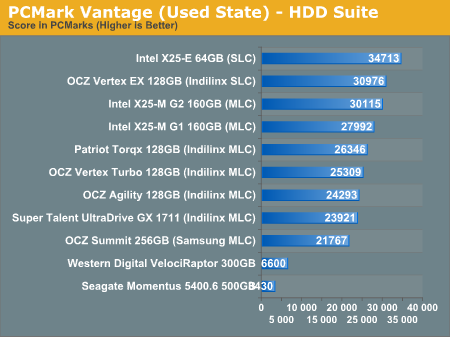
The breakdown between SSDs here is almost linear. The X25-E leads the pack, followed by OCZ's SLC drive. The G2 and G1 are next, then a ton of Indilinx MLC drives. The slowest SSD? The Samsung based Summit of course.










295 Comments
View All Comments
Wwhat - Sunday, September 6, 2009 - link
If you read the first part of the article alone you would see how important a good controller is in a SSD and you would no ask his question probably, plus SSD's use the flash in parallel where a bunch of USB drives would not, the parallel thing is also mentioned in the article.And USB has a lot of overhead actually on the system, both in CPU cycles as well as in IO interrupts.
There are plug in PCI(e) cards to stick SD cards in though, to get a similar setup, but it's a bit of a hack and with the overhead and the management and controllers used and the price to buy many SD cards it's not competitive in the end and you are better of with a real SSD I'm told.
Transisto - Sunday, September 6, 2009 - link
You are right, the controller is very important.I think caching about 4-8 gig of most often accessed program files has the best price/performance ratio, for improving application load time. It it also very easily scalable.
One of the problem I see is integrating this ssd cache in the OS or before booting so it act where it matter the most.
I think there could be a near x25-m speedup from optimized caching and good controller no matter what SSD form factor it rely on. SD, CF, usb , pci or onboard.
Why it seams nobody talk about eboostr type of caching AND ,,, on other news ,,, Intel's Braidwood flash memory module could kill SSD market.
I am quite of a performance seeker.
But I don't think I need 80gig of SSD in my desktop,just some 8gb of good caching. Mabe a 60gb ssd on a laptop.
Well... I'm gonna pay for that controller once, not twice (160gb?)
Wwhat - Saturday, September 5, 2009 - link
Not that it's not a good article, although it does seem like 2 articles in one, but what I miss is getting to brass tacks regarding the filesystem used, and why there isn't a SSD-specific file system made, and what choices can be made during formatting in regards to blocksize, obviously if you select large blocks on filesystem level a would impact he performance of the garbage collection right? It actually seem the author never delved very deeply into filesystems from reading this.The thing is that even with large blocks on filesystem level the system might still use small segments for the actuall keepin track, and if it needs to write small bits to keep track of large blocks you'd still have issues, that's why I say a specific SSD filesystem migh be good, but only if there isn't a new form of SSD in the near future that makes the effort poinless, and if a filesystem for SSD was made then the firmware should not try to compensate for exising filesystem issues with SSD's.
I read that the SD people selected exFAT as filesystem for their next generation, and that also makes me wonder, is that just to do with licensing costs or is NTFS bad for flash based devices?
Point being at the filesystem needs to be highlighted more I think,
Bolas - Friday, September 4, 2009 - link
Would someone please hit Dell with the clue-board and convince them to offer the Intel SSD's in their Alienware systems? The Samsung SSD's are all that is stopping me from buying an Alienware laptop at the moment.EatTheMeat - Friday, September 4, 2009 - link
Congratulations on another fab masterclass. This is easily the best educational material on the internet regarding SSDs, and contrary to some comments, I think you've pitched your recommendations just right. I can also appreciate why you approached this article with some trepidation. Bravo.I have a RAID question for Anand (or anyone else who feels qualified :-))
I'm thinking of setting up 2 160GB x25-m G2 drives in RAID-0 for Win 7. I'd simply use the ICH10R controller for it. It's not so much to increase performance but rather to increase capacity and make sure each drive wears equally. After considering it further I'm wondering if SSD RAID is wise. First there's the eternal question of stripe size and write amplification. It makes sense to me to set the stripe size to be the same as, or a fraction of, the block size of the SSD. If you choose the wrong stripe size does it influence write amplification?
I'm aware that performance should increase with larger spripes, but I'm more concerned about what's healthy for the SSD.
Do you think I should just let SSD RAID wait until RAID drivers are optimised for SSDs?
I know you're planning a RAID article for SSDs - I for one look forward to it greatly. I've read all your other SSD articles like four times!
Bolas - Friday, September 4, 2009 - link
If SSD's in RAID lose the benefit of the TRIM command, then you're shooting yourself in the foot if you set them up in RAID. If you need more capacity, wait for the Intel 320GB SSD drives next year. Or better yet, use a 160 GB for your boot drive, then set up some traditional hard disk drives in RAID for your storage requirements.EatTheMeat - Friday, September 4, 2009 - link
Thanks for reply. I definitely hear you about the TRIM functionality as I doubt RAID drivers will pass this through before 2010. Still though, it doesn't look like the G2s drop much in performance with use anyway from Anand's graphs. With regard to waiting for 320 GB drives - I can't. These things are just too enticing, and you could always say that technology will be better / faster / cheaper next year. I've decided to take the plunge now as I'm fed up with an i7 965 booting and loading apps / games like a snail even from a RAID drive.I just don't want to bugger the SSDs up with loads of write amplification / fragmentation due to RAID-0. ie, is RAID-0 bad for the health of SSDs like defragmentation / prefetch is? I wonder if anyone knows the answer to this question yet.
jagreenm - Saturday, September 5, 2009 - link
What about just using Windows drive spanning for 2 160's?EatTheMeat - Saturday, September 5, 2009 - link
As far as I know drive spanning doesn't even the wear between the discs. It just fills up first one and then the other. That's important with SSDs because RAID can really help reduce drive wear by spreading all reads and writes across 2 drives. In fact, it should more than half drive wear as both drives will have large scratch portions. Not so with spanning as far as I know.Does anyone know if I'm talking sh1t here? :-)
pepito - Monday, November 16, 2009 - link
If you are not sure, then why do you assert such things?I don't know about Windows, but at least in Linux when using LVM2 or RAID0 the writes spread evenly against all block devices.
That means you get twice the speed and better drive wear.
I would like to think that microsoft's implementation works more or less the same way, as this is completely logical (but then again, its microsoft, so who can really know?).